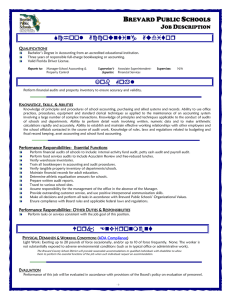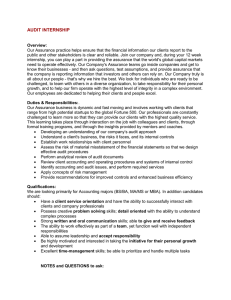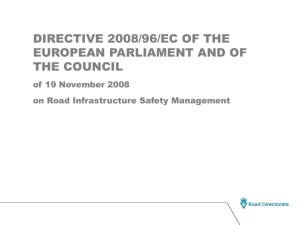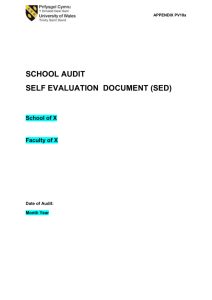Trust Board Meeting: Wednesday 14 January 2015 TB2015.11 Title
advertisement
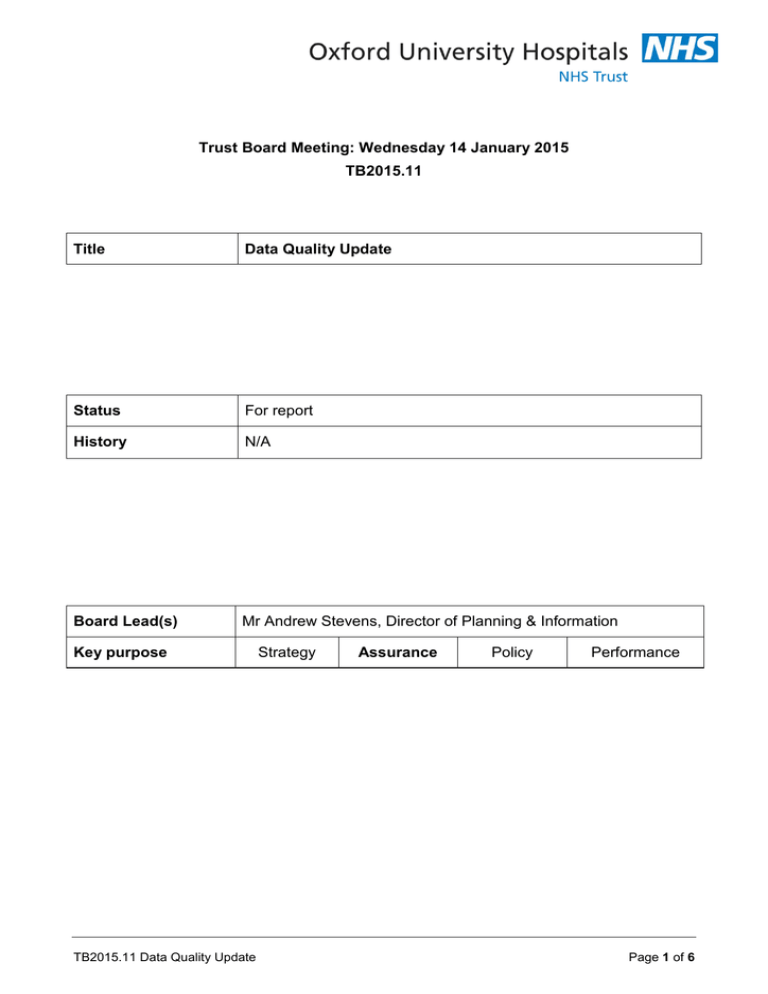
Trust Board Meeting: Wednesday 14 January 2015 TB2015.11 Title Data Quality Update Status For report History N/A Board Lead(s) Mr Andrew Stevens, Director of Planning & Information Key purpose TB2015.11 Data Quality Update Strategy Assurance Policy Performance Page 1 of 6 Oxford University Hospitals TB2015.11 Executive Summary 1. The attached paper updates the Trust Board on the Trust’s data quality activities and performance. 2. The Trust has established a data quality infrastructure which is overseen by the Information Governance and Data Quality Group (IGDQG). 3. The IGDQG oversees: • The development of policies, procedures and training. • The implementation of a data quality assurance framework that assesses the quality of data underpinning the key performance indicators in the Trust’s Integrated Performance Report. • A programme of external and internal data quality audits. • Data quality benchmarking. The IGDQG will be seeking to ensure that it adopts a more structure approach to the consideration of adhoc internal and external data quality issues. 4. Recommendation The Trust Board is asked to note the contents of this paper. In future it is proposed that an update on the Trust data quality activities and performance is included in the six monthly information governance updates to the Trust Board. TB2015.11 Data Quality Update Page 2 of 6 Oxford University Hospitals TB2015.11 Data Quality update 1. Introduction 1.1. The purpose of this paper is to provide an update to the Trust Board on data quality activities within the Trust. 1.2. The paper describes the data quality assurance mechanisms and updates the Board on data quality performance and issues. 2. Data Quality assurance activities 2.1. The Board is assured of the quality of data used within the Trust for both clinical and management purposes by means of a data quality infrastructure that comprises data quality structures and a data quality strategy supported by appropriate policies and procedures. 2.2. The Information Governance and Data Quality Group (IGDQG) meet every six weeks and reports to the Health Informatics Committee, a sub-committee of the Trust Management Executive. 2.3. Each Division has a corresponding group which oversees data quality activity within the Division. The Divisional Groups report to the IGDQG. The IGDQG produces policies, procedures and training on information and data quality. 2.4. The IGDQG also administers the Data Quality Assurance Framework that underpins the quality of the data relating to all of the key performance indicators that are contained within the Trust’s Integrated Performance Report. Each integrated performance report indicator is assigned a composite data quality rating. The data quality rating comprises: • A rating of 1-5 based on the level of assurance obtained • A red/amber/green rating to indicate the level of confidence in the indicator based on the available level of assurance. 2.5. The details of the rating system are shown in the tables below. Data Quality Assurance Framework A rating of 1 to 5 to identify the level of assurance available as per the table below: Rating Required Evidence Rating Required Evidence 1 Standard operating procedures and data definitions are in place. 2 As 1 plus: Staff recording the data have been appropriately trained. 3 As 2 plus: The department/service has undertaken its own audit. 4 As 2 plus: A corporate audit has been undertaken. TB2015.11 Data Quality Update Page 3 of 6 Oxford University Hospitals TB2015.11 Rating Required Evidence 5 As 2 plus: An independent audit has been undertaken (e.g. by the Trust’s internal or external auditors). A traffic-light rating to assess the quality of the data as per the table below: Rating Data Quality Rating Data Quality Green Satisfactory Amber Data can be relied upon but minor areas for improvement identified. Red Unsatisfactory/significant areas for improvement identified. 2.6. All indicator ratings and supporting evidence are held on the Trust’s Health Assure system. Each indicator owner is required to review the data quality of their indicators on a quarterly basis. The rating given to each indicator and the evidence supporting this rating is reviewed annually by the IGDQG. 2.7. The Trust’s data quality activities are also underpinned by a programme of external and internal audits. External audit of the Trust’s quality account takes place each year and includes substantive testing of sample quality indicators. The latest audit of the Quality Account by the Trust’s external auditors was considered by the Board’s Audit Committee at its September meeting. The audit looked at the following indicators: • % of patient safety incidents that resulted in sever harm or death • Rate of clostridium difficile infections 2.8. The data quality underpinning both indicators was found to be robust and compliant with the relevant guidance. 2.9. The Trust’s internal auditors review data quality on an annual basis as an integral part of the annual audit plan. The annual audits examine the robustness of the Trust’s data quality infrastructure and test the data quality of specific performance indicators. The indicators looked at in the last two annual data quality audits are set out below: • April 2013 • 4 hour emergency department waits • Aseptic non touch technique injectables (one of the safety thermometer indicators) • March 2014 • Delayed transfers of care • Pressure ulcers TB2015.11 Data Quality Update Page 4 of 6 Oxford University Hospitals TB2015.11 • Sickness absence 2.10. Both the April 2013 and March 2014 audits, which were reported to the Board’s Audit Committee, were rated as providing significant assurance. 2.11. The 2015 data quality audit will be looking at the indicators set out below: • Urgent Cancellations • Cancellations re-booked within 28 days • Falls 2.12. The IGDQG also administers a programme of quarterly divisional data quality audits. The programme consists of a combination of mandatory audits which all Divisions must undertake which are determined by the IGDQG and discretionary audits which the Divisions can select for themselves. Each audit that appears on the menu of audits is supported by a detailed audit brief which includes advice on how to apply the data quality diamond to the audit. The data quality diamond looks at the six dimensions of data quality: validity, reliability, completeness, timeliness, accuracy and relevance. 2.13. In addition to this programme of audits, the Divisions also undertake a monthly programme of validation of key performance data underpinning the A&E 4 hour standard, the referral to treatment 18 week waiting time standard and the cancer waiting time standards. 2.14. A programme of coding audits is undertaken by the Trust’s Coding Department in collaboration with individual specialities. These are also reported to the IGDQG. 2.15. The action plans resulting from the audits are monitored either by the IGDQG for corporate audits or by the Divisional Groups for divisional audits. 2.16. Benchmarking is also undertaken at each IGDQG meeting of the Trust’s data quality using the National Secondary User Service Data Quality Dashboard. The Trust’s performance is benchmarked both against national performance levels and against local comparator Trusts. The latest set of data demonstrates that the Trust is performing at 99.1% against the overall data quality measure compared to the national target of 96%. It is also the highest performing Trust against the local comparator Trusts. 2.17. The IGDQG seeks to ensure that it learns the lessons from both internal and external data quality issues, and is seeking to strengthen the way it performs this task. 2.18. The recent transfer of Nuffield Orthopaedic Centre RTT data from the Infoflex system on to the Cerner Millennium 18 weeks module identified the need to ensure that all systems and their applications are brought within the Data Quality Assurance Framework described above. The structured implementation of the framework using Health Assure supports this. 2.19. Following data quality issues at Colchester NHS Foundation Trust surrounding cancer data, the Trust undertook its own local internal audit, which demonstrated that the same problems did not exist within the Trust. TB2015.11 Data Quality Update Page 5 of 6 Oxford University Hospitals 3. TB2015.11 Conclusion 3.1. The Trust Board is asked to note the contents of this paper. 3.2. In future, it is proposed that updates on the Trust’s data quality activities and performance are included in the six monthly information governance updates to the Trust Board. Andrew Stevens Director of Planning & Information 16 December 2014 TB2015.11 Data Quality Update Page 6 of 6


